Eli Lilly & Co. V. Watson Pharmaceuticals (changzhou) Co., Ltd.(2015) MSZZ No. 1, SPC
Eli Lilly & Co. V. Watson Pharmaceuticals (changzhou) Co., Ltd.(2015) MSZZ No. 1, SPC
ELI LILLY & CO. V. WATSON PHARMACEUTICALS (CHANGZHOU) CO., LTD. (2015) MSZZ No. 1, SPC
Cause of action: Dispute over infringement of a patented invention right
Collegial panel members: Zhou Xiang | Wu Rong | Song Shuhua
Keywords: infringement of a patented invention right, invention patent for method of manufacturing a drug, scope of protection, technical investigator, verification of the preparation methodology for an allegedly infringing drug
Relevant legal provisions: Civil Procedure Law of the People's Republic of China (as amended in 2012), articles 78 and 79 Patent Law of the People's Republic of China (as amended in 2000), articles 56(1), 57(2) and 62(1)
Basic facts: On July 25, 2013, Eli Lilly and Co. (hereinafter "Lilly") filed with the Jiangsu Higher People's Court (hereinafter the "Jiangsu Higher Court") a claim affirming Lilly's right to protection under Patent No. 91103346.7, which registered the invention of a method of preparing the drug olanzapine. When prepared using the patented method, the drug comprised a new product. When Watson Pharmaceuticals (Changzhou) Co., Ltd. (hereinafter "Watson") produced olanzapine using a method of preparation allegedly falling within the scope of Lilly's patent protection and sold it in the market, Lilly claimed that this constituted infringement of its patent right. Lilly consequently asked the court to order Watson to: (a) compensate Lilly for its economic losses of RMB151,060,000 and to pay another RMB28,800 in costs, to cover the investigation fee and other reasonable expenses incurred by Lilly, with the aim of deterring further infringement; (b) publish a statement on its website and in the journal Medical Economics to mitigate the adverse effects of its infringement on Lilly; (c) bear Lilly's legal representation costs of RMB1.5 million; and (d) to bear all other costs incurred in the case. The Jiangsu Higher Court affirmed that the patent involved was Chinese Invention Patent Application No. 91103346.7, entitled "Method to prepare a thieno-benzodiazepines compound", which Lilly Industrial Company of the United Kingdom applied for on April 24, 1991. The patent was granted and published in the Patent Gazette on February 19, 1995, and it expired on April 24, 2011. The name of the patentee was changed to Eli Lilly Ltd of the United Kingdom on March 17, 1998, and then to Eli Lilly and Company on February 28, 2002.
The patent granted involved "a method to prepare 2-methyl-10-(4-methyl-1- piperazinyl)-4H-thieno-[2,3,-b][1,5] benzodiazepine, or an acid salt thereof".
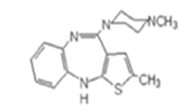
The method specified included: (a) "reacting N-methylpiperazine and a compound [as illustrated] in which Q is a radical capable of being split off";
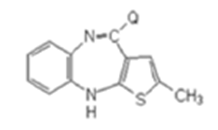
(b) "triggering a ring-closure reaction of a compound [as illustrated]".
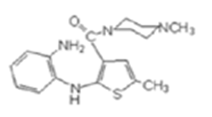
In July 2001, Watson and the Institute of Medica of the Chinese Academy of Medical Sciences (hereinafter the "Institute of Medicine") submitted to the State Food and Drug Administration (hereinafter the "SFDA") a new drug application (NDA) for olanzapine and olanzapine tablets. On May 9, 2003, the SFDA issued the Institute of Medicine and Watson with a new drug certificate for olanzapine and olanzapine tablets, and Watson obtained drug registration approval for olanzapine and olanzapine tablets. The method of preparation was recorded, in an NDA document entitled "Research Materials and Literature on the Production Methodology of API [activepharmaceutical ingredient]", as follows:
Add 4-amino-2-methyl-10- benzyl-thieno-benzodiazepines, hydrochloride, methyl piperazine and dimethylformamide, stir to the crude product, with a yield coefficient of 94.5%; then add 2-methyl-10-benzyl-(4- methyl-1-piperazinyl)-4H-thienobenzodiazepine, glacial acetic acid and hydrochloric acid, stir to get the crude product, with a yield coefficient of 73.2%; then with two more refinements, the total yield coefficient becomes 39.1%.
Based on analysis of the formula, the process is to react the compound in Formula 4 with methyl piperazine to create the compound in Formula 5, and then to debenzylate the compound in Formula 5 to create the compound in Formula 1. In August 2003, Watson sold its own novel antipsychotic dru "Watson-Olanzapine" to Qingdao Seventh People's Hospital. As recorded in marketing literature for the product, the main component of the olanzapine tablet is olanzapine, the chemical name of which is 2-methyl-10-(4-methyl-1- piperazinyl)-4H-thieno-benzodiazepines.
In a different case heard before the Jiangsu High Court ((2010) JZ No. 19), the Shanghai Science and Technology Consulting Service Center had issued a technical expert report dated August 25, 2011, in which it stated that the API olanzapine could not be obtained by means of the process described in the "Production Methodology" document that Watson had filed. The expert's conclusion was that the key reaction step recorded in that document as producing the API olanzapine was inauthentic and that the production methodology filed was not feasible.
After cross-examination in the present case, Lilly accepted the expert report and Watson did not raise any objection to it. Watson did, however, insist that the "two-step" method could produce olanzapine, alleging that the expert had failed to replicate it when following the instructions outlined in the "Production Methodology" only because some of the ingredients, which involved trade secrets, were omitted from that document. Watson argued that it had not infringed upon Lilly's patent right for the following reasons. It asserted that it had been using the filed olanzapine-producing technology since 2003, after the date on which it submitted a supplementary application, which was approved in 2008. The SFDA had approved the filed "Production Methodology" document on September 8, 2010, after evaluating its feasibility. In the absence of Lilly providing any evidence challenging Watson's production methodology, the method of production for olanzapine that Watson filed in 2008 should be the basis on which infringement should be assessed.
In the "Application Content" column of an Approval Letter on Supplementary Application for Drugs that Watson subsequently submitted to the SFDA on September 8, 2010, Watson indicated that it intended to "1. change the production methodology that may affect the quality of drug; 2. revise the drug registration standard". In the "Approval Conclusion" column, the Letter concluded: After review, agree to change the production methodology and revise the quality standard. There is no other change in the production methodology other than with respect to the solvents and reagents used in the preparation method. The original route of synthesis remains unchanged. The quality standard is attached and is valid for 24 months.
In the text of a subsection "5.1.1 Technology Route", under the heading "5.1 Research Materials and Literature on the Production Methodology of API", in the "Supplementary and Registration Information for Olanzapine" attached to the 2010 Approval Letter, Watson stated that:
Based on the actual production condition of the API olanzapine, we have made partial adjustment and optimization of the olanzapine preparation methodology without changing the originally reported production route, to further guarantee and improve the quality of olanzapine intermediates and to effectively control relevant impurities during preparation process … As neither the technology route nor the crystal-solvent used in the last step has been changed, the structure and morphology of the compound will not change.
In a second-instance hearing before the Supreme People's Court aiming to ascertain the technical facts involved in this case, Lilly was allowed to engage an expert advisor to appear on its behalf, in accordance with the provisions of article 79 of the Civil Procedure Law of the People's Republic of China and article 122 of the Interpretation of the Supreme People's Court Concerning the Application of Civil Procedure Law of the People's Republic of China (hereinafter the "Interpretation of Civil Procedure Law"). Watson was allowed to call witnesses to appear in court, in accordance with the provisions under article 117 of the Interpretation of Civil Procedure Law. The member of staff at the Jiangsu Science and Technology Consulting Service Center who issued Technical Validation Report (2014) SJD No. 02 was also called to appear in court, in accordance with the provisions of article 78 of the Civil Procedure Law of the People's Republic of China and article 227 of the Interpretation of Civil Procedure Law. In accordance with the provisions of articles 2 and 10 of the Temporary Provisions of the Supreme People's Court on Several Issues Concerning the Litigation Participation by Technical Investigators in the Intellectual Property Court, technical investigators were appointed to appear in court for the first time to examine the expert advisor, witnesses and appraiser, as well as the parties, about the relevant technical issues. On appeal, the Supreme People's Court found that Watson had signed a technology transfer contract with the Institute of Medicine, dated October 28, 1999, pursuant to which the Institute of Medicine transferred its independently developed anti-schizophrenia drug olanzapine and its formulation to Watson. The Institute of Medicine had been responsible for completing the applications for pre-clinical and clinical research approval in Beijing. The acceptance criteria are subject to the standards of approval for new drugs, and the procedure for acceptance involves obtaining both clinical approval documents and new drug certificates. In other words, both parties agreed on the new drug certificate and approval for production. In its Application Form for Clinical Research of New Drugs (J99) YSLZ No. 82, which the Institute of Medicine completed and submitted in October 1999, the reaction route described in the "Preparation Methodology" column is as illustrated.
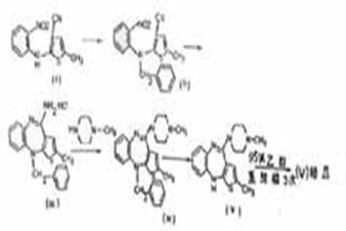
On March 5, 2015, the Jiangsu Science and Technology Consulting Center, as commissioned by the Shanghai Fangda Law Firm (Beijing), issued its Technical Validation Report (2014) SJZ No. 02, in which it recorded, under the heading "Validation Conclusion", that: 1. The olanzapine preparation methodology filed by Watson with the SFDA is feasible. 2. By comparing the olanzapine preparation methodology filed by Watson in 2008 with the SFDA, with Lilly's methodology in paten tNo. 91103346.7, it is found that the initial materials of both are secondary amine compounds, however, their preparation methodology differs in: 1) the key intermediates produced in the reaction are different; 2) the reaction steps are different: it is a Four-Step Method for Watson and Two-Step Method for Lilly, respectively; 3) the reaction conditions are different: the solvent used by Watson in the substitution reaction is dimethylformamide and that used by Lilly is a mixed solvent composed of dimethyl sulfoxide and methylbenzene.
On appeal to the Supreme People' s Court, Lilly clarified that it sought to protect the patented method (a) in its first claim in the case (that is, "reacting N-methylpiperazine and a compound [as illustrated] in which Q is a radical capable of being split off").
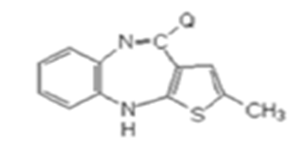
Held: At first instance, the Jiangsu Higher People's Court made a civil ruling on October 14, 2014 ((2013) SMCZ No. 0002), in which it: (a) ordered Watson to compensate Lilly RMB3.5 million for its economic loss and other reasonable fees involved, as a method of deterring further infringement; and (b) dismissed Lilly's other claims. With respect to the court fee of RMB809,744, Lilly was to pay RMB161,950 and Watson was to pay RMB647,794. Both Lilly and Watson were dissatisfied with the ruling and appealed. The Supreme People's Court made a civil ruling in which it reversed the finding at first instance and dismissed Lilly's claim. The total court fees of the two proceedings were RMB809,744, of which Lilly was ordered to pay RMB323,897 and Watson, RMB1,295,591.
Reasoning: On appeal, the Supreme People's Court held that it is stipulated under article 7 of the Interpretation of the Supreme People's Court on Several Issues Concerning the Application of Law in the Trial of Cases of Infringement upon Intellectual Property Rights that: When the People's Court determines whether the alleged infringing technical solution falls within the scope of patent right protection, all technical features recorded in the claim by the patentee should be reviewed. In the event that the alleged infringing technical solution contains the same or equivalent technical features as those of the claim, the People's Court shall determine that it falls within the scope of patent right protection; in the event that the alleged infringing technical solution lacks one or more technical features compared to all of those recorded by the claim, or contains one or more technical features that is (are) not the same or not equivalent with those of the claim, the People's Court shall determine that it does not fall within the scope of patent right protection.
In this case, the allegedly infringing drug produced and sold by Watson was the same as the product prepared by using the patented method involved in the case – that is, both were olanzapine; therefore, the following three questions were to be answered to determine whether the Watson's preparation methodology fell within the scope of Lilly's patent protection.
I. Scope of patent protection
Article 56(1) of the Patent Law of the People's Republic of China provides that: "For the patent right in an invention or a utility model, the scope of protection shall be confined to what is claimed, and the written description and the pictures attached may be used to explain what is claimed." In this case, Lilly required protection of method (a) of the first claim in its process patent (that is, "reacting N-methylpiperazine and a compound [as illustrated] in which Q is a radical capable of being split off").
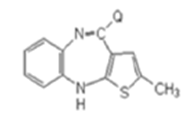
The claim is drafted in an open-ended manner, in which only the tricyclic reduction, N-methylpiperazine and group participating in the substitution reaction are defined. The scope of protection covers all methods of preparing olanzapine by using tricyclic reduction and N-methylpiperazine with a substitution reaction with Q, regardless of the materials used to start the reaction, the solvent and the reaction conditions. The key to determining whether Watson's method for preparing olanzapine falls within the scope of Lilly's patent protection lies in comparing the reaction routes in the two technical solutions, while excluding the materials used to start the reaction, the solvent and the reaction conditions from the comparison; otherwise, the scope of the patent protection involved in this case will be reduced improperly, and Lilly's legitimate rights and interests will be damaged.
II. Method of preparing olanzapine that Watson actually used
Article 57(2) of the Patent Law of the People's Republic of China provides that:"If a dispute over patent infringement involves an invention patent for the method of manufacturing a new product, the unit or individual manufacturing the same product shall provide evidence to show that the manufacturing method of their own product is different from the patented method." In the present case, neither party has any objection to the fact that the new product claimed in the process patent is olanzapine; Watson should bear the burden of proving that its method of preparing olanzapine is different from the patented method. Specifically, Watson should provide evidence to prove that the reaction route actually used within its olanzapine preparation methodology does not fall within the scope of protection of the patent right involved. If it fails to do so, Watson will be held liable and its infringement will be affirmed based on its inability to provide evidence otherwise.
In this case, Watson claims that it has in fact been using, since 2003, a methodology to prepare olanzapine that it lodged in a supplementary filing with the SFDA in 2008, and it has submitted as evidence the batch manufacturing records of 2003 and 2008(Supplementary Evidence #6 at first instance), the production regulations of2003, 2007 and 2013 (Supplementary Evidence #7 at first instance), and the Approval Letter on Supplementary Application for Drugs (Supplementary Evidence #12 at first instance). As noted above, the key to assessing infringement in this case lies in comparing the reaction routes of the two technical solutions. The reaction route of the process in Watson's 2008 supplementary filing can be seen in the Registration Information on the Supplementary Application for Olanzapine that it submitted to the SFDA, in which the text of "5.1.2 Technology Route", under the heading "5.1 Research Materials and Literature Materials on the Manufacturing Technique of API", outlines the reaction route as being, first, to protect the secondary amino group of "secondary amine compound" with benzyl to produce a "benzyl compound"(benzylation), and then to trigger a ring-closure reaction to produce a "benzyl substituted thieno-benzodiazepines" tricyclic compound (reduction compound). Next, the amine group of the "reduction compound" is substituted by N-methylpiperazine to produce a"condensation compound" and, finally, the olanzapine is produced through adebenzylation reaction.
The Supreme People's Court held that there was documented evidence that could form a complete chain of evidence proving that Watson had been producing olanzapine using the reaction route described in its 2008 supplementary filing since 2003 through to the expiry date of the patent right involved. The main reasons for the Court's finding areas follows.
First, Watson submitted the supplementary application for registration of olanzapine to the SFDA in the Registration Information on Supplementary Application for Olanzapine, which clearly records the reaction route of the olanzapine preparation methodology. After receiving the supplementary application, the Jiangsu FDA inspected Watson's production site and took samples of the product on July 7 and August 25,2009, respectively, and it subsequently issued its Onsite Inspection Report for Drug Registration and Productions(Reference No. CXHB0800159), in which it affirmed that Watson's "production process is conducted in accordance with the declared methodology", that three batches of products "were sampled in accordance with the sampling requirements" and that the on-site inspection was "Passed". This means that the process Watson described in its 2008 supplementary filing is feasible, based on the on-site inspection conducted by the Jiangsu FDA. Based on this finding, the SFDA issued to Watson its Approval Letter on Supplementary Application for Drugs, dated September 8, 2010, allowing Watson to "change the production process and revise the quality standard" of olanzapine. Lilly's expert advisor acknowledged the feasibility of the process described in Watson's 2008supplementary filing at the appeal hearing. The Technical Validation Report (2014) SJZ No. 02 issued by Jiangsu Science and Technology Consulting Service Center also concluded that "Watson's preparation process for olanzapine described in its 2008 filing with the SFDA is feasible". In conclusion,532 Patent cases Patent cases in the absence of other evidence to the contrary, it should be presumed that the process Watson outlines in its 2008supplementary filing is the methodology it has in fact used to prepare olanzapinesince it obtained the Approval Letter on Supplementary Application for Drugs.
Secondly, the application of a methodology for drug preparation in large-scale industrial production is often cumbersome and complicated, and consequently it cannot be refined overnight. The long-term process of technology accumulation, from research and development through to actual production, usually involves optimizing reaction conditions and operation details based on defects identified during actual production, within the necessary constraints of maintaining the basic stability of the reaction route. Watson's methodology for preparing olanzapine was transferred from the Institute of Medicine according to a technology transfer contract dated October 28, 1999, under which the Institute of Medicine had been responsible for completing the applications for pre-clinical and clinical research approval in Beijing. In its Application Form for Clinical Research of New Drugs (J99) YSLZ No. 82, which the Institute of Medicine filed and submitted in October 1999, the reaction route described in the "Preparation Methodology" column is the same as that described in Watson's 2008supplementary filing. On November 9,1999, the Beijing Municipal Health Bureau issued its Onsite Assessment Report for New Drug Development based on the application for clinical research involving a new drug, in which it confirmed that: "The original records and experimental data are basically complete and the contents thereof are true." Based on this affirmation, the Institute of Medicine and Watson jointly submitted, under the technology transfer contract, the Application Form for New Drug Certificate and Production (2001) JSCZ No. 019. As per the application, the Jiangsu FDA issued its On Site Assessment Report for New Drug Development on October 22, 2001, confirming that: "The original records of sample preparation and inspection are basically complete." After passing all reviews, including this assessment, the SFDA issued the Institute of Medicine and Watson with a new drug certificate for olanzapine and olanzapine tablets. Thus it can be seen that Watson has consistently used the same olanzapine preparation methodology, with the same reaction route as that stipulated in the2008 supplementary filing, and had already obtained a new drug certificate by registering for a new drug application. It is therefore unlikely that Watson would have produced olanzapine using a very different preparation methodology at any time before the 2008 supplementary filing.
Finally, it is recorded in the "Approval Conclusion" column of the Approval Letter on Supplementary Application for Drugs that: "The revised production methodology has no other adjustment except with respect to the solvents and reagents used in the preparation methodology on the basis of not changing the original synthetic route." In other words, the SFDA confirmed that the reaction route outlined in Watson's 2008 supplementary filing is the same as that outlined in its earlier submissions. Watson submitted as evidence to the first-instance court its production regulations of 2003, 2007and 2013, as well as its olanzapine batch manufacturing records of 2003 and2008. Because Watson claimed that the evidence involved trade secrets, the court of first instance submitted both parties to closed cross-examination so that it could determine the authenticity and relevance of this claim. On reflection, the court found the olanzapine batch manufacturing records of 2003 and2008 to be records of actual production conducted in line with the production regulations of 2003 and 2007. Both the production regulations and batch manufacturing records show that the basic reaction route of Watson's olanzapine preparation methodology is the same as that which it filed in its2008 supplementary filing, with only such minor adjustments and refinements of details such as reaction conditions and solvents as could be made without altering the basic reaction route. Such a process of technology accumulation is in line with the actual method of production.
To sum up, the Supreme People's Court held Watson's 2008 supplementary filing to be authentic and feasible, and affirmed that Watson has been producing olanzapine by means of the reaction route outlined in its supplementary filing of 2008 since 2003 through to the expiry date of the patent right involved.
III. Whether Lilly's claim of infringement could be substantiated
In comparing the reaction route described in Watson's olanzapine preparation methodology with the process patent involved in the case, the Court found the differences between them to lie in the reaction steps and key intermediates. To be more specific, the amine group of the tricyclic reduction that Watson's olanzapine preparation methodology uses is protected by benzyl; thus the benzylation reaction certainly existed before the substitution reaction to produce the benzylated tricyclic reduction and the debenzylation reaction step also certainly existed after the substitution reaction to produce olanzapine. However, there is no benzy lprotection for the amine group of tricyclic reduction used in the patented process, and there are no corresponding steps for benzylation and debenzylation.
Article 17(2) of Several Provisions of the Supreme People's Court Concerning the Application of Law in the Trial of Cases Involving Patent Disputes provides that: An equivalent feature is a feature that has the same function and achieves the same effect through the same means as claimed in the patent application or granted patent, according to a person with ordinary skill in the field and without undue experimentation .
In this case, the differences in reaction routes between Watson's olanzapine preparation methodology and the patented process lie, first, in the fact that the intermediate of tricyclic reduction protected by benzyl differs from that of tricyclic reduction without benzyl protection. There are differences in characteristics between the chemical reactions – namely, both the Q group and amine group on the tricyclic reduction intermediate without benzyl protection can react with N-methylpiperazine, while that on the tricyclic reduction intermediate protected by benzyl does not have undesired substitution reactions with N-methylpiperazine. The substitution reaction happens only at the Q group. Correspondingly, there are no steps of benzylation and debenzylation before and after the substitution reactions in the methodology of Lilly's patent. There is therefore a big difference between the two technical solutions in terms of reaction intermediates and reaction steps. Secondly, the final product yield coefficient of Watson's preparation Patent methodology is reduced by the steps of benzylation and debenzylation compared to that of the patented method. There is therefore a big difference between the two technical solutions in terms of technical effects such as yield coefficient.
Lastly, although it is common knowledge in the field of chemical synthesis that imposing benzyl protection for the amine group of tricyclic reduction will reduce adverse reactions, the effect of such a change is substantial. It will change the reaction characteristics of the tricyclic reduction intermediate and the added reaction step will reduce the yield coefficient. Moreover, the common knowledge of imposing benzyl protection indicates only that Watson's preparation methodology is a relatively limited improvement on the patented method involved; it does not mean that the technical means used by Watson and Lilly are basically the same.
In summary, Watson's method of preparing olanzapine differs from Lilly's patented method in terms of whether the intermediates of tricyclic reduction are benzylated intermediates, as well as with respect to the added steps of benzylation and debenzylation. The corresponding technical features do not belong to the same technical means. There is a big difference in the technical effects achieved and no equivalent feature has been established. For this reason, Watson's preparation methodology does not fall within the scope of protection afforded by Lilly's process patent. In conclusion, since Watson's olanzapine preparation methodology does not fall within the scope of protection under Lilly's process patent, the court of first instance erred in its assessment off acts and in the application of law in its judgment, and this decision should be remedied in accordance with the law.







